2018 North Island farm forester of the year field day - Dean Satchell
Yvonne Steinemann, October 2018
Vertically Integrated Forest Operation - Horowai Trust, Purerua Peninsula, Kerikeri
- High value forest 150 ha, aiming for good quality timber for high end use and a good return
- Diverse products, harvest thinnings, resource marketed over time
- Will be mixed age forest in future with selective extraction
- Diversity of options gives resilience
- We need to realise higher value from our alternative species
- Industry and government has not supported genetic improvement of the cypress and eucalypt forestry species and management for the past 30 years
- Building industry and standards dominated by treated pine ideology
- Research and data collection urgently needed from existing NZ farm forestry stands along with development of alternative building experience
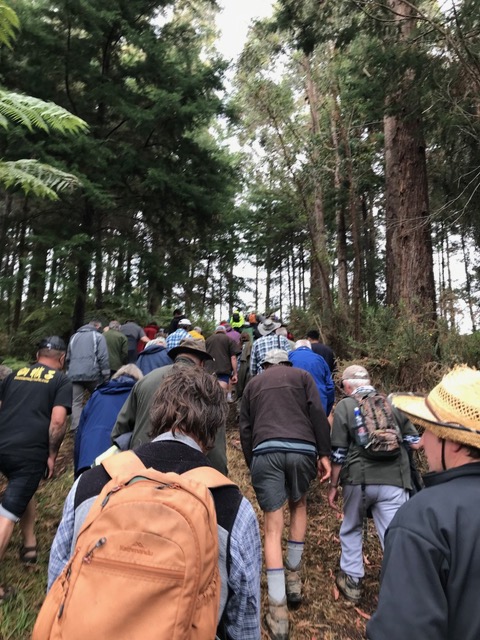
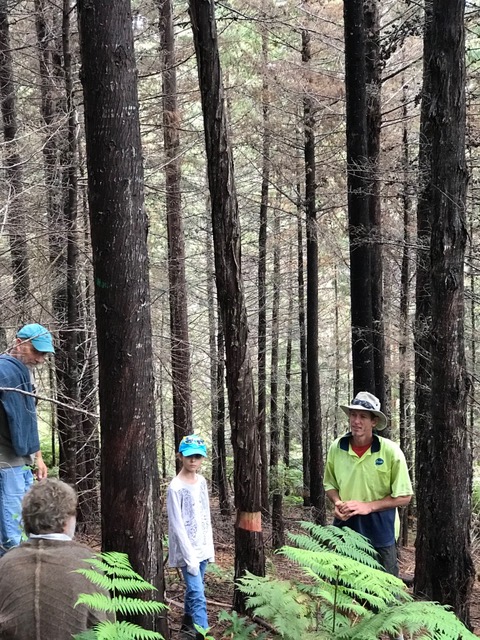
This is a poor fertiity site and quite wet in places with a pan. Podzol soils are cement in summer and wet in winter. The property was previously farm land and pine forest.
Failures on this site:
- Poplars – not fertile enough.
- E. cladocalyx – There were large trees in Whangarei, but all died here.
- E. quadrangulata – won't grow again, wide sapwood band, insects hammer it. Fast early growth but fairly slow growth later. There are better choices.
- Acacia sylvestris and A. prominens – possibly a provenance issue, would be willing to try other provenances.
Showing promise
- E. scias subspecies callimastha and E. notabilis (red mahoganies), these are some of the best Aussie east coast timber species, rich red mahogany type timber, durable and hard but workable, likes damp soils; grew well in NZ in Puhipuhi forest until the 1920’s when Paropsis (tortoise beetle) pest arrived, now a bio-control has helped control this.
- Acacia melanoxylon – good eucalypt understory and ladybird host (predator for eucalypt pests). Difficult to grow for timber though.
- E. sphaerocarpa Blackdown stringybark – excellent durable timber, introduced in 1995 just before it became impossible to import seed for new species. Has species affinities to ash and stringybark eucalypts, so vaguely related to E. pilularis, E. muelleriana and E. delegatensis.
Good on exposed hill country with poor soils, good potential for Northland. Frost tender, grows slowly for the first 5 years like E. microcorys, has been graveyard tested for stiffness and durability, done best of all eucs. Dean wants more planted here in Northland. - E. saligna – grows on poorly drained site but needs to be a good size log for harvest (same for E. botryoides) as the core gets compression fractures (shakes) and the sapwood is wide and pale.
- E. maculata Spotted gum - A bad seedline from Australia is showing poor form here, others are good. A species suitable for exposed sites including coastal salt wind. Hard, strong timber used for tool handles. Good wind resistance; better seed available from Australia now with improved form.
- E. botryoides – handles wind better than E. saligna; a high stocking rate is a good idea to overcome form issues.
- E. muelleriana Yellow stringybark – good here, good timber properties and nice to mill, bread and butter species. Stringybarks in general grow best down off ridges.
- Acacia elata – good timber, long-lived, fixes nitrogen which is valuable on this poor fertility site.
- Acacia binervata – showing promise for timber production as an easier-to-grow replacement for blackwood.
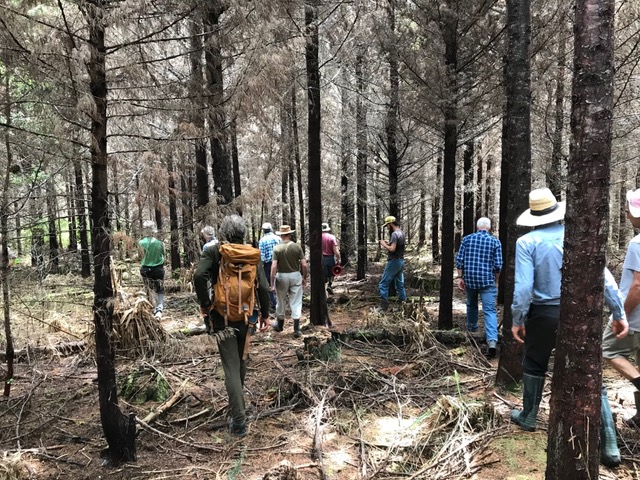
Planting and Management
Continuous canopy forestry
- Aim for single tree harvesting and continuous cover.
- Plant a high stocking rate (2000 stems per hectare) for self pruning and to choose best trees as have options with so many. The high capital outlay is outweighed by cost effective silviculture and more quality trees to select from.
- High initial stocking allows the grower to keep a higher density for longer, pruning is delayed allowing bigger lifts.
- Always consider timber quality vs growth rate. Pruning and delayed thinning slow growth initially, but with slower diameter growth smaller branches die, loosen in socket then drop out, for good quality log higher up.
- Pine shelter rows can be good windbreak on exposed sites. Plant ahead of high-value crop.
- Plant 4 metre wide rows, 1.5 m spacing within row, allows small machinery access.
- Ring barking to thin = tree slowly dies and drops material without damaging neighbouring trees, remaining trees not suddenly exposed to open gaps in forest, slower more gentle transition. However, don't walk in forest in the wind!
- Thinning gives girth to residual trees, gets rid of poorly-formed trees and is essential.
- Dont replant skid sites - keep them open. The soil is compacted and trees wont grow well. They offer good bee hive and future mill sites and for timber storage.
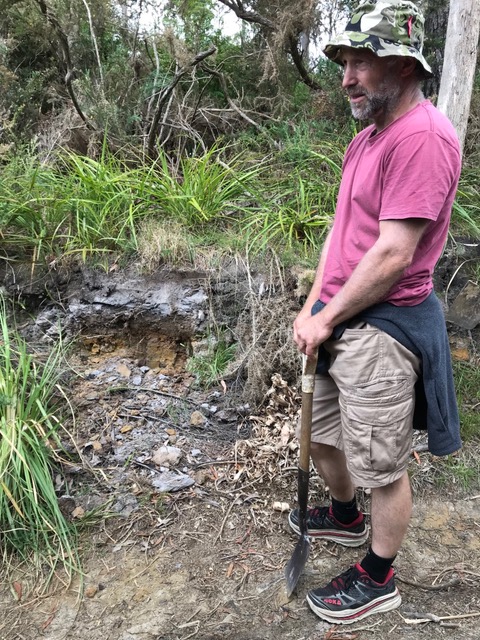
Ringbark thinning
Dean uses a battery electric recipro saw for ringbarking and 3% glyphosate solution (3 X spray rate strength) using a spray bottle, spraying around bottom of debarked ring, very quick, can work on his own. Drilling and chemical application could affect roots that are grafted to crop trees you want to keep. In contrast, chainsaw thinning needs 2 people to be safe.
Simple thinning prescription: With a high initial stocking, at 6 or 7 years old, ringbark dominant poor form trees. A year or two later look for co-dominants (2 good trees together) and ringbark one. These are the two most important silvicultural operations. One or two ringbark thinnings can follow to bring the stocking rate to what is required for the desired average diameter.
E. muelleriana stand managment
By age 13, aim for 400 – 600 stems per hectare final spacing. This is in contrast to traditional stocking rate 150 – 300 stems per hectare. Traditional spacing was for big butt logs with large volumes of clear heartwood, but this regime is risky for subsequent wind damage and requires long rotation lengths. New methods mean smaller diameter logs can be milled with good grade recoveries.
About 50% have been thinned to waste until now, with a final thin to waste of 20%, with only production thinning in future.
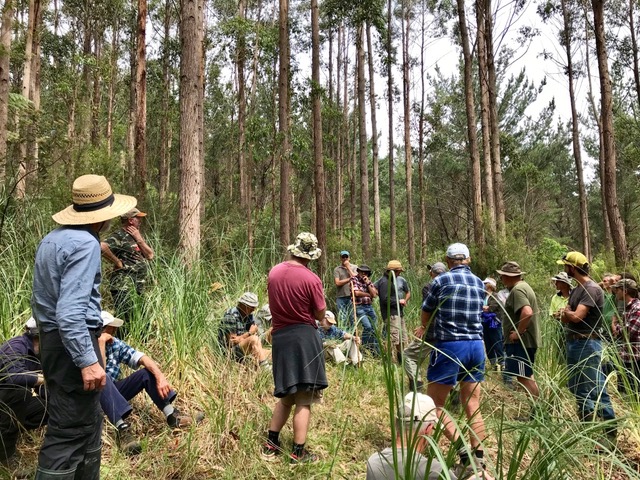
Harvesting options now:
- Vineyard posts can be cut from 25 cm + diameter trunks (quartered). Stringybarks only have 1 – 2 cm sapwood, lots of heartwood.
- 30 cm + trunks can give 60% recovery for flooring product
- Demand for exterior (heartwood) decking
- Eucalypts coppice and can be managed successfully for further rotations without replanting
- Woodmizer mill can handle up to 80 cm diameter trunks but the best sizes are 40-60 cm.
Interplanting thoughts:
Dont use pines, use acacias or cypresses with eucalypts. Interplanting allows the trees that best suit the microsite to dominate. Acacias have high value timber and offer choice later in the rotation. Wattles like A. dealbata and A. mearnsii are weed species and should not be planted, recommmend A. elata and A. binervata.

 Farm Forestry New Zealand
Farm Forestry New Zealand